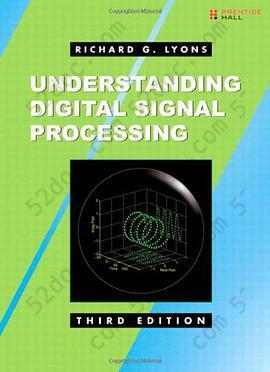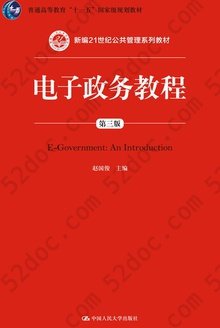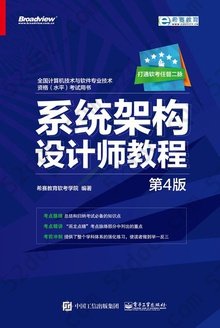注重体验与质量的电子书资源下载网站
分类于: 人工智能 计算机基础
简介

Understanding Digital Signal Processing 豆 9.6分
资源最后更新于 2020-09-17 15:01:18
作者:Richard G. Lyons
出版社:Prentice Hall
出版日期:2010-01
ISBN:9780137027415
文件格式: pdf
标签: 数字信号处理 DSP 英文原版 Signal.Processing 通信原理 通俗易懂 教材 communication
简介· · · · · ·
Amazon.com's Top-Selling DSP Book for Seven Straight Years--Now Fully Updated! Understanding Digital Signal Processing, Third Edition, is quite simply the best resource for engineers and other technical professionals who want to master and apply today's latest DSP techniques. Richard G. Lyons has updated and expanded his best-selling second edition to reflect the newest technol...
目录
PREFACE
ABOUT THE AUTHOR
1 DISCRETE SEQUENCES AND SYSTEMS
1.1 Discrete Sequences and Their Notation
1.2 Signal Amplitude, Magnitude, Power
1.3 Signal Processing Operational Symbols
1.4 Introduction to Discrete Linear Time-Invariant Systems
1.5 Discrete Linear Systems
1.6 Time-Invariant Systems
1.7 The Commutative Property of Linear Time-Invariant Systems
1.8 Analyzing Linear Time-Invariant Systems
2 PERIODIC SAMPLING
2.1 Aliasing: Signal Ambiguity in the Frequency Domain
2.2 Sampling Lowpass Signals
2.3 Sampling Bandpass Signals
2.4 Practical Aspects of Bandpass Sampling
3 THE DISCRETE FOURIER TRANSFORM
3.1 Understanding the DFT Equation
3.2 DFT Symmetry
3.3 DFT Linearity
3.4 DFT Magnitudes
3.5 DFT Frequency Axis
3.6 DFT Shifting Theorem
3.7 Inverse DFT
3.8 DFT Leakage
3.9 Windows
3.10 DFT Scalloping Loss
3.11 DFT Resolution, Zero Padding, and Frequency-Domain Sampling
3.12 DFT Processing Gain
3.13 The DFT of Rectangular Functions
3.14 Interpreting the DFT Using the Discrete-Time Fourier Transform
4 THE FAST FOURIER TRANSFORM
4.1 Relationship of the FFT to the DFT
4.2 Hints on Using FFTs in Practice
4.3 Derivation of the Radix-2 FFT Algorithm
4.4 FFT Input/Output Data Index Bit Reversal
4.5 Radix-2 FFT Butterfly Structures
4.6 Alternate Single-Butterfly Structures
5 FINITE IMPULSE RESPONSE FILTERS
5.1 An Introduction to Finite Impulse Response (FIR) Filters
5.2 Convolution in FIR Filters
5.3 Lowpass FIR Filter Design
5.4 Bandpass FIR Filter Design
5.5 Highpass FIR Filter Design
5.6 Parks-McClellan Exchange FIR Filter Design Method
5.7 Half-band FIR Filters
5.8 Phase Response of FIR Filters
5.9 A Generic Description of Discrete Convolution
5.10 Analyzing FIR Filters
6 INFINITE IMPULSE RESPONSE FILTERS
6.1 An Introduction to Infinite Impulse Response Filters
6.2 The Laplace Transform
6.3 The z-Transform
6.4 Using the z-Transform to Analyze IIR Filters
6.5 Using Poles and Zeros to Analyze IIR Filters
6.6 Alternate IIR Filter Structures
6.7 Pitfalls in Building IIR Filters
6.8 Improving IIR Filters with Cascaded Structures
6.9 Scaling the Gain of IIR Filters
6.10 Impulse Invariance IIR Filter Design Method
6.11 Bilinear Transform IIR Filter Design Method
6.12 Optimized IIR Filter Design Method
6.13 A Brief Comparison of IIR and FIR Filters
7 SPECIALIZED DIGITAL NETWORKS AND FILTERS
7.1 Differentiators
7.2 Integrators
7.3 Matched Filters
7.4 Interpolated Lowpass FIR Filters
7.5 Frequency Sampling Filters: The Lost Art
8 QUADRATURE SIGNALS
8.1 Why Care about Quadrature Signals?
8.2 The Notation of Complex Numbers
8.3 Representing Real Signals Using Complex Phasors
8.4 A Few Thoughts on Negative Frequency
8.5 Quadrature Signals in the Frequency Domain
8.6 Bandpass Quadrature Signals in the Frequency Domain
8.7 Complex Down-Conversion
8.8 A Complex Down-Conversion Example
8.9 An Alternate Down-Conversion Method
9 THE DISCRETE HILBERT TRANSFORM
9.1 Hilbert Transform Definition
9.2 Why Care about the Hilbert Transform?
9.3 Impulse Response of a Hilbert Transformer
9.4 Designing a Discrete Hilbert Transformer
9.5 Time-Domain Analytic Signal Generation
9.6 Comparing Analytical Signal Generation Methods
10 SAMPLE RATE CONVERSION
10.1 Decimation
10.2 Two-Stage Decimation
10.3 Properties of Downsampling
10.4 Interpolation
10.5 Properties of Interpolation
10.6 Combining Decimation and Interpolation
10.7 Polyphase Filters
10.8 Two-Stage Interpolation
10.9 z-Transform Analysis of Multirate Systems
10.10 Polyphase Filter Implementations
10.11 Sample Rate Conversion by Rational Factors
10.12 Sample Rate Conversion with Half-band Filters
10.13 Sample Rate Conversion with IFIR Filters
10.14 Cascaded Integrator-Comb Filters
11 SIGNAL AVERAGING
11.1 Coherent Averaging
11.2 Incoherent Averaging
11.3 Averaging Multiple Fast Fourier Transforms
11.4 Averaging Phase Angles
11.5 Filtering Aspects of Time-Domain Averaging
11.6 Exponential Averaging
12 DIGITAL DATA FORMATS AND THEIR EFFECTS
12.1 Fixed-Point Binary Formats
12.2 Binary Number Precision and Dynamic Range
12.3 Effects of Finite Fixed-Point Binary Word Length
12.4 Floating-Point Binary Formats
12.5 Block Floating-Point Binary Format
13 DIGITAL SIGNAL PROCESSING TRICKS
13.1 Frequency Translation without Multiplication
13.2 High-Speed Vector Magnitude Approximation
13.3 Frequency-Domain Windowing
13.4 Fast Multiplication of Complex Numbers
13.5 Efficiently Performing the FFT of Real Sequences
13.6 Computing the Inverse FFT Using the Forward FFT
13.7 Simplified FIR Filter Structure
13.8 Reducing A/D Converter Quantization Noise
13.9 A/D Converter Testing Techniques
13.10 Fast FIR Filtering Using the FFT
13.11 Generating Normally Distributed Random Data
13.12 Zero-Phase Filtering
13.13 Sharpened FIR Filters
13.14 Interpolating a Bandpass Signal
13.15 Spectral Peak Location Algorithm
13.16 Computing FFT Twiddle Factors
13.17 Single Tone Detection
13.18 The Sliding DFT
13.19 The Zoom FFT
13.20 A Practical Spectrum Analyzer
13.21 An Efficient Arctangent Approximation
13.22 Frequency Demodulation Algorithms
13.23 DC Removal
13.24 Improving Traditional CIC Filters
13.25 Smoothing Impulsive Noise
13.26 Efficient Polynomial Evaluation
13.27 Designing Very High-Order FIR Filters
13.28 Time-Domain Interpolation Using the FFT
13.29 Frequency Translation Using Decimation
13.30 Automatic Gain Control (AGC)
13.31 Approximate Envelope Detection
13.32 A Quadrature Oscillator
13.33 Specialized Exponential Averaging
13.34 Filtering Narrowband Noise Using Filter Nulls
13.35 Efficient Computation of Signal Variance
13.36 Real-time Computation of Signal Averages and Variances
13.37 Building Hilbert Transformers from Half-band Filters
13.38 Complex Vector Rotation with Arctangents
13.39 An Efficient Differentiating Network
13.40 Linear-Phase DC-Removal Filter
13.41 Avoiding Overflow in Magnitude Computations
13.42 Efficient Linear Interpolation
13.43 Alternate Complex Down-conversion Schemes
13.44 Signal Transition Detection
13.45 Spectral Flipping around Signal Center Frequency
13.46 Computing Missing Signal Samples
13.47 Computing Large DFTs Using Small FFTs
13.48 Computing Filter Group Delay without Arctangents
13.49 Computing a Forward and Inverse FFT Using a Single FFT
13.50 Improved Narrowband Lowpass IIR Filters
13.51 A Stable Goertzel Algorithm
A THE ARITHMETIC OF COMPLEX NUMBERS
A.1 Graphical Representation of Real and Complex Numbers
A.2 Arithmetic Representation of Complex Numbers
A.3 Arithmetic Operations of Complex Numbers
A.4 Some Practical Implications of Using Complex Numbers
B CLOSED FORM OF A GEOMETRIC SERIES
C TIME REVERSAL AND THE DFT
D MEAN, VARIANCE, AND STANDARD DEVIATION
D.1 Statistical Measures
D.2 Statistics of Short Sequences
D.3 Statistics of Summed Sequences
D.4 Standard Deviation (RMS) of a Continuous Sinewave
D.5 Estimating Signal-to-Noise Ratios
D.6 The Mean and Variance of Random Functions
D.7 The Normal Probability Density Function
E DECIBELS (DB AND DBM)
E.1 Using Logarithms to Determine Relative Signal Power
E.2 Some Useful Decibel Numbers
E.3 Absolute Power Using Decibels
F DIGITAL FILTER TERMINOLOGY
G FREQUENCY SAMPLING FILTER DERIVATIONS
G.1 Frequency Response of a Comb Filter
G.2 Single Complex FSF Frequency Response
G.3 Multisection Complex FSF Phase
G.4 Multisection Complex FSF Frequency Response
G.5 Real FSF Transfer Function
G.6 Type-IV FSF Frequency Response
H FREQUENCY SAMPLING FILTER DESIGN TABLES
I COMPUTING CHEBYSHEV WINDOW SEQUENCES
I.1 Chebyshev Windows for FIR Filter Design
I.2 Chebyshev Windows for Spectrum Analysis
INDEX
ABOUT THE AUTHOR
1 DISCRETE SEQUENCES AND SYSTEMS
1.1 Discrete Sequences and Their Notation
1.2 Signal Amplitude, Magnitude, Power
1.3 Signal Processing Operational Symbols
1.4 Introduction to Discrete Linear Time-Invariant Systems
1.5 Discrete Linear Systems
1.6 Time-Invariant Systems
1.7 The Commutative Property of Linear Time-Invariant Systems
1.8 Analyzing Linear Time-Invariant Systems
2 PERIODIC SAMPLING
2.1 Aliasing: Signal Ambiguity in the Frequency Domain
2.2 Sampling Lowpass Signals
2.3 Sampling Bandpass Signals
2.4 Practical Aspects of Bandpass Sampling
3 THE DISCRETE FOURIER TRANSFORM
3.1 Understanding the DFT Equation
3.2 DFT Symmetry
3.3 DFT Linearity
3.4 DFT Magnitudes
3.5 DFT Frequency Axis
3.6 DFT Shifting Theorem
3.7 Inverse DFT
3.8 DFT Leakage
3.9 Windows
3.10 DFT Scalloping Loss
3.11 DFT Resolution, Zero Padding, and Frequency-Domain Sampling
3.12 DFT Processing Gain
3.13 The DFT of Rectangular Functions
3.14 Interpreting the DFT Using the Discrete-Time Fourier Transform
4 THE FAST FOURIER TRANSFORM
4.1 Relationship of the FFT to the DFT
4.2 Hints on Using FFTs in Practice
4.3 Derivation of the Radix-2 FFT Algorithm
4.4 FFT Input/Output Data Index Bit Reversal
4.5 Radix-2 FFT Butterfly Structures
4.6 Alternate Single-Butterfly Structures
5 FINITE IMPULSE RESPONSE FILTERS
5.1 An Introduction to Finite Impulse Response (FIR) Filters
5.2 Convolution in FIR Filters
5.3 Lowpass FIR Filter Design
5.4 Bandpass FIR Filter Design
5.5 Highpass FIR Filter Design
5.6 Parks-McClellan Exchange FIR Filter Design Method
5.7 Half-band FIR Filters
5.8 Phase Response of FIR Filters
5.9 A Generic Description of Discrete Convolution
5.10 Analyzing FIR Filters
6 INFINITE IMPULSE RESPONSE FILTERS
6.1 An Introduction to Infinite Impulse Response Filters
6.2 The Laplace Transform
6.3 The z-Transform
6.4 Using the z-Transform to Analyze IIR Filters
6.5 Using Poles and Zeros to Analyze IIR Filters
6.6 Alternate IIR Filter Structures
6.7 Pitfalls in Building IIR Filters
6.8 Improving IIR Filters with Cascaded Structures
6.9 Scaling the Gain of IIR Filters
6.10 Impulse Invariance IIR Filter Design Method
6.11 Bilinear Transform IIR Filter Design Method
6.12 Optimized IIR Filter Design Method
6.13 A Brief Comparison of IIR and FIR Filters
7 SPECIALIZED DIGITAL NETWORKS AND FILTERS
7.1 Differentiators
7.2 Integrators
7.3 Matched Filters
7.4 Interpolated Lowpass FIR Filters
7.5 Frequency Sampling Filters: The Lost Art
8 QUADRATURE SIGNALS
8.1 Why Care about Quadrature Signals?
8.2 The Notation of Complex Numbers
8.3 Representing Real Signals Using Complex Phasors
8.4 A Few Thoughts on Negative Frequency
8.5 Quadrature Signals in the Frequency Domain
8.6 Bandpass Quadrature Signals in the Frequency Domain
8.7 Complex Down-Conversion
8.8 A Complex Down-Conversion Example
8.9 An Alternate Down-Conversion Method
9 THE DISCRETE HILBERT TRANSFORM
9.1 Hilbert Transform Definition
9.2 Why Care about the Hilbert Transform?
9.3 Impulse Response of a Hilbert Transformer
9.4 Designing a Discrete Hilbert Transformer
9.5 Time-Domain Analytic Signal Generation
9.6 Comparing Analytical Signal Generation Methods
10 SAMPLE RATE CONVERSION
10.1 Decimation
10.2 Two-Stage Decimation
10.3 Properties of Downsampling
10.4 Interpolation
10.5 Properties of Interpolation
10.6 Combining Decimation and Interpolation
10.7 Polyphase Filters
10.8 Two-Stage Interpolation
10.9 z-Transform Analysis of Multirate Systems
10.10 Polyphase Filter Implementations
10.11 Sample Rate Conversion by Rational Factors
10.12 Sample Rate Conversion with Half-band Filters
10.13 Sample Rate Conversion with IFIR Filters
10.14 Cascaded Integrator-Comb Filters
11 SIGNAL AVERAGING
11.1 Coherent Averaging
11.2 Incoherent Averaging
11.3 Averaging Multiple Fast Fourier Transforms
11.4 Averaging Phase Angles
11.5 Filtering Aspects of Time-Domain Averaging
11.6 Exponential Averaging
12 DIGITAL DATA FORMATS AND THEIR EFFECTS
12.1 Fixed-Point Binary Formats
12.2 Binary Number Precision and Dynamic Range
12.3 Effects of Finite Fixed-Point Binary Word Length
12.4 Floating-Point Binary Formats
12.5 Block Floating-Point Binary Format
13 DIGITAL SIGNAL PROCESSING TRICKS
13.1 Frequency Translation without Multiplication
13.2 High-Speed Vector Magnitude Approximation
13.3 Frequency-Domain Windowing
13.4 Fast Multiplication of Complex Numbers
13.5 Efficiently Performing the FFT of Real Sequences
13.6 Computing the Inverse FFT Using the Forward FFT
13.7 Simplified FIR Filter Structure
13.8 Reducing A/D Converter Quantization Noise
13.9 A/D Converter Testing Techniques
13.10 Fast FIR Filtering Using the FFT
13.11 Generating Normally Distributed Random Data
13.12 Zero-Phase Filtering
13.13 Sharpened FIR Filters
13.14 Interpolating a Bandpass Signal
13.15 Spectral Peak Location Algorithm
13.16 Computing FFT Twiddle Factors
13.17 Single Tone Detection
13.18 The Sliding DFT
13.19 The Zoom FFT
13.20 A Practical Spectrum Analyzer
13.21 An Efficient Arctangent Approximation
13.22 Frequency Demodulation Algorithms
13.23 DC Removal
13.24 Improving Traditional CIC Filters
13.25 Smoothing Impulsive Noise
13.26 Efficient Polynomial Evaluation
13.27 Designing Very High-Order FIR Filters
13.28 Time-Domain Interpolation Using the FFT
13.29 Frequency Translation Using Decimation
13.30 Automatic Gain Control (AGC)
13.31 Approximate Envelope Detection
13.32 A Quadrature Oscillator
13.33 Specialized Exponential Averaging
13.34 Filtering Narrowband Noise Using Filter Nulls
13.35 Efficient Computation of Signal Variance
13.36 Real-time Computation of Signal Averages and Variances
13.37 Building Hilbert Transformers from Half-band Filters
13.38 Complex Vector Rotation with Arctangents
13.39 An Efficient Differentiating Network
13.40 Linear-Phase DC-Removal Filter
13.41 Avoiding Overflow in Magnitude Computations
13.42 Efficient Linear Interpolation
13.43 Alternate Complex Down-conversion Schemes
13.44 Signal Transition Detection
13.45 Spectral Flipping around Signal Center Frequency
13.46 Computing Missing Signal Samples
13.47 Computing Large DFTs Using Small FFTs
13.48 Computing Filter Group Delay without Arctangents
13.49 Computing a Forward and Inverse FFT Using a Single FFT
13.50 Improved Narrowband Lowpass IIR Filters
13.51 A Stable Goertzel Algorithm
A THE ARITHMETIC OF COMPLEX NUMBERS
A.1 Graphical Representation of Real and Complex Numbers
A.2 Arithmetic Representation of Complex Numbers
A.3 Arithmetic Operations of Complex Numbers
A.4 Some Practical Implications of Using Complex Numbers
B CLOSED FORM OF A GEOMETRIC SERIES
C TIME REVERSAL AND THE DFT
D MEAN, VARIANCE, AND STANDARD DEVIATION
D.1 Statistical Measures
D.2 Statistics of Short Sequences
D.3 Statistics of Summed Sequences
D.4 Standard Deviation (RMS) of a Continuous Sinewave
D.5 Estimating Signal-to-Noise Ratios
D.6 The Mean and Variance of Random Functions
D.7 The Normal Probability Density Function
E DECIBELS (DB AND DBM)
E.1 Using Logarithms to Determine Relative Signal Power
E.2 Some Useful Decibel Numbers
E.3 Absolute Power Using Decibels
F DIGITAL FILTER TERMINOLOGY
G FREQUENCY SAMPLING FILTER DERIVATIONS
G.1 Frequency Response of a Comb Filter
G.2 Single Complex FSF Frequency Response
G.3 Multisection Complex FSF Phase
G.4 Multisection Complex FSF Frequency Response
G.5 Real FSF Transfer Function
G.6 Type-IV FSF Frequency Response
H FREQUENCY SAMPLING FILTER DESIGN TABLES
I COMPUTING CHEBYSHEV WINDOW SEQUENCES
I.1 Chebyshev Windows for FIR Filter Design
I.2 Chebyshev Windows for Spectrum Analysis
INDEX







